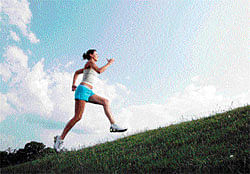Between the run and the walk, falls the jog

“Look out of the window and you’ll see joggers with a slow and sticky rhythm, poor posture, and that heavy heel strike into the pavement,” said Lee Saxby, a running coach who has worked with many an injured weekend warrior at his clinic in the West Hampstead section of London, England.
Saxby, author of a new ebook “Proprioception: Making Sense of Barefoot Running”, said the three most important aspects of healthy running, whether fast or slow, are good posture, a bouncing, elastic rhythm and a forefoot landing.
“Human beings will naturally walk, sprint or run. Walking is a heel strike, running is a forefoot strike,” he said. Jogging is not a slow run.
Jogging is actually a different biomechanical behaviour, a hybrid between a walk and a run. Distance runners never land on their heels.” What’s often lost in jogging in heavily cushioned shoes, according to Saxby, is proprioception: the body’s awareness of posture, movement and balance.
“There is a natural pattern that’s good for you, and an unnatural pattern that’s bad for you,” he explained.
Dr Mark Cucuzzella, associate professor of family medicine at West Virginia University and a competitive runner for 30 years, said while human beings walk in a heel-to-toe pattern, running is really a series of short hops. “So if you land on your fore and mid-foot you use the recoil aspect of the foot, which is designed to return energy,” he said. “The benefits of a daily walk or jog are enormous, but we need to teach people good mechanics, which is not landing hard on the heel.”
As an orthopedic surgeon specialising in sports medicine at Tufts Medical Center in Boston, Massachusetts, Dr Elizabeth Matzkin sees a lot of jogging injuries, from runner’s knee to shin splints to stress fractures.
Yet Matzkin, a spokesperson for the American Academy of Orthopedic Surgeons, thinks jogging is one of the safer ways to stay fit, as long as you approach it thoughtfully and build up gradually.
“The 10 per cent rule goes for beginners and established runners alike,” she said. “You shouldn’t increase your mileage, or your time, more than 10 per cent per week.” She suggests wearing a stabilising shoe.
“A lot of injuries are from patients who throw on an old pair of sneakers,” she said. “If you’re going to jog regularly you need a good stability, cushioning shoe for shock absorption.”
Matzking said shoes should be replaced every 300 miles or so because studies have shown they lose about 60 per cent of their shock absorption.